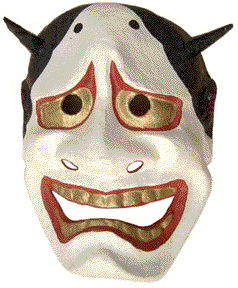
In Japan masks belong to a highly developed theatrical tradition. Its purpose used to be strictly religious but this has long since changed. Of all the Japanese masks the Noh mask is said to be the most artistic one. The origins of Noh theatre go back to the thirteenth century. At that time a very popular performance was ‘Dengaku no Noh’ which translates as ‘Field-music Performance’ and it had its root in rustic acrobatic and juggling exhibitions. By the fourteenth century, however, Noh had become a kind of opera in which the performers recited while sitting next to each other and then danced. As the fourteenth century went on, another type of Noh, Sarugaku, which used a lot of buffoonery, developed into a serious dramatic performance.
In 1647 the shogun Tokugawa Iemitsu (the Shogun was the Japanese military ruler) ordered that no variations were allowed in Noh performance. At that time stage directions were written down, costumes and masks were clearly defined and actors were allocated fixed positions on stage.
Elaborate costumes are a very important part of creating a striking performance. If a play begins rather slowly it is likely that the audience will get bored, therefore the Noh actors choose bright and colourful costumes. Costumes can also help to communicate a special context, so a broad-brimmed hat made of bamboo would suggest country life. These expensive costumes were often gifts to a famous actor by his admirers, something that still happens today.
Stage props on the other hand were hardly needed at all. More important than the costume was the Noh mask. Masks are only worn by the main character, his mask would stylise the person it represents and show them in a truer light than reality could do by depicting only the absolutely essential traits of character. There are five categories of Noh masks: gods, demons, men, women and the elderly.
The masks used in Noh theatre generally show a neutral expression so it is up to the skill of the actor to bring the mask to life through his acting. The parts are all acted by men, so the task of performing as a young woman is one of the most challenging for any actor. The masks are comparatively small and they only cover the front of the face having only small holes for eyes, nostrils and mouth.
Noh masks have to be very light because they are worn throughout a performance that lasts for several hours. They are carved from one piece of cypress wood. After the masks has been carved to the desired thickness, holes for eyes, nose and mouth have been cut, it is then coated with layers of gesso mixed with glue. This coating is then sanded down, giving the mask its final shape. Finally it is painted in the colours prescribed for the particular character and some parts of it might be gilded. Some of the masks’ eyes are inlaid with metal leaving a tiny hole. The hair and the outlines of the eyes are traced with black ink.